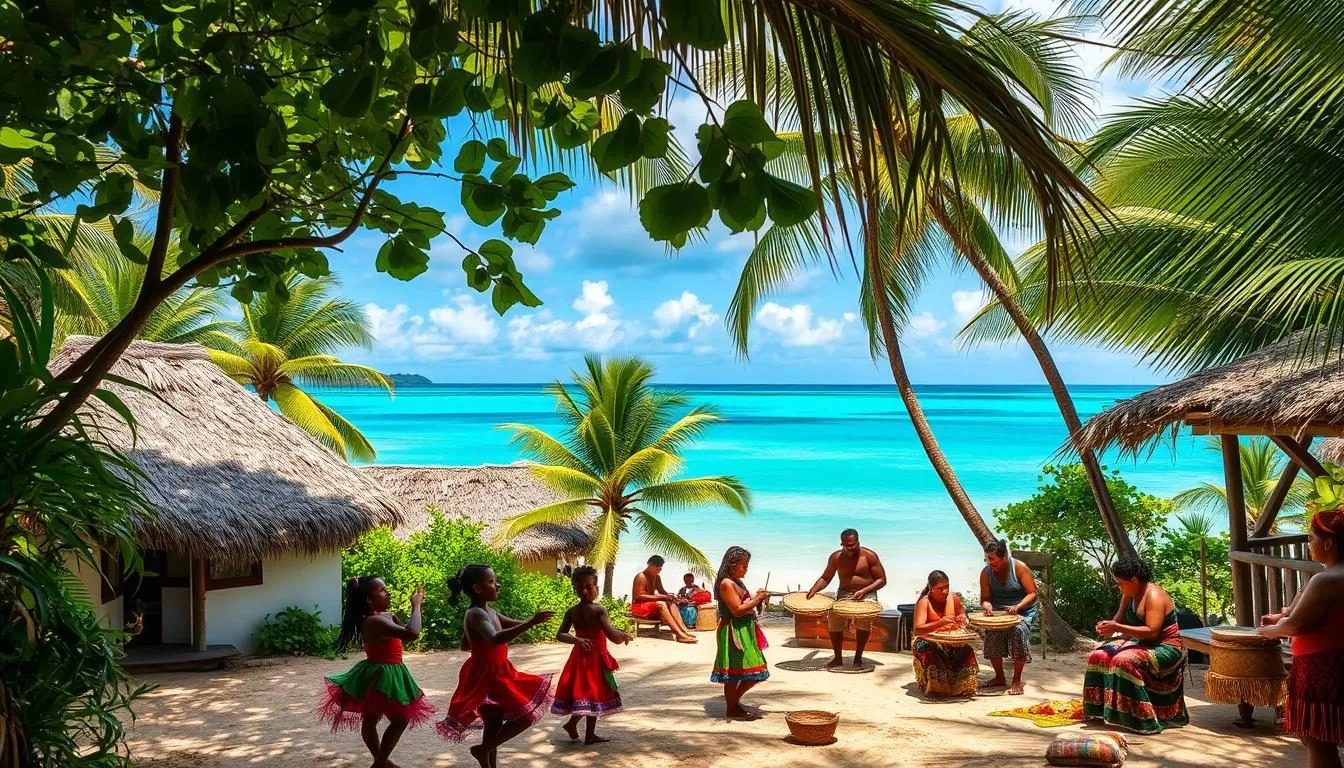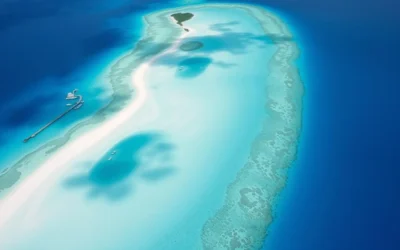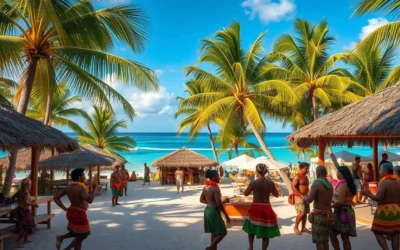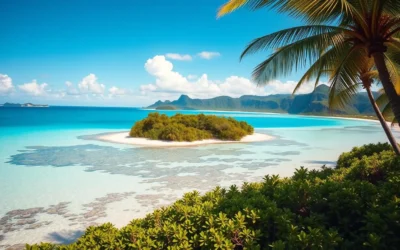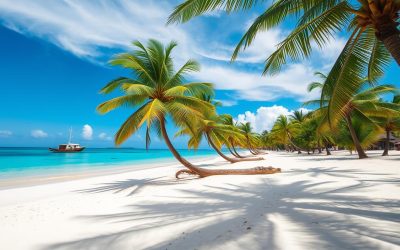✓ Accommodations✓ Flights✓ Rental Cars
Nestled in the Pacific Ocean, Tuvalu is a small island country with a rich Polynesian heritage. Its language plays a vital role in shaping its cultural identity. Tuvaluan and English are the primary languages used here, reflecting the nation’s history and modern influences.
With a population of around 10,645, Tuvalu’s linguistic diversity is deeply tied to its community life. Tuvaluan, a Polynesian dialect, is spoken by over 13,000 people worldwide, including those in New Zealand. This language is more than just a means of communication—it’s a symbol of unity and tradition.
As you explore this country, you’ll discover how its language connects its people to their roots. From the Ellice Islands to modern-day Tuvalu, the story of its linguistic heritage is both fascinating and inspiring.
Introduction to Tuvalu’s Unique Linguistic Heritage
The linguistic heritage of this Pacific nation is deeply rooted in its history. Over the years, the islands have been shaped by early Polynesian migrations and cultural exchanges. These events laid the foundation for the language you hear today, connecting the community to its ancestral roots.
This nation’s culture is a blend of tradition and adaptation. The sea has always played a central role, influencing daily life and shaping the way people communicate. With a population of around 11,000, the islands remain one of the least populated places on Earth. Yet, their linguistic identity is vibrant and deeply tied to their shared history.
Language here is more than just words—it’s a part of who they are. It reflects their struggles, triumphs, and the bonds that unite them. Each person carries a piece of this heritage, ensuring it lives on for future generations.
Overview of Tuvalu’s History and Culture
The islands’ history is marked by resilience and adaptation. From early settlers to modern times, the sea has been both a lifeline and a challenge. The nation gained independence in 1978, but its cultural roots stretch back centuries.
Today, the community thrives on its traditions, with language at the heart of it all. The islands’ unique geography, with their low-lying coral atolls, has shaped their way of life. This connection to the land and sea is reflected in their words and stories.
Importance of Language in Community Identity
Language is a powerful tool for preserving culture. It binds the community together, offering a sense of belonging and continuity. For many, it’s a way to honor their ancestors and pass down wisdom to the next generation.
In this nation, every word carries meaning. Whether spoken in daily conversations or sung in traditional songs, language is a living part of their identity. It’s a testament to their resilience and a reminder of their shared history.
Historical Evolution of Tuvaluan Language
From ancient voyages to modern times, the Tuvaluan language has evolved uniquely. Early Polynesian settlers arrived by canoe, bringing their dialects and traditions. These voyages laid the foundation for the language you hear today.
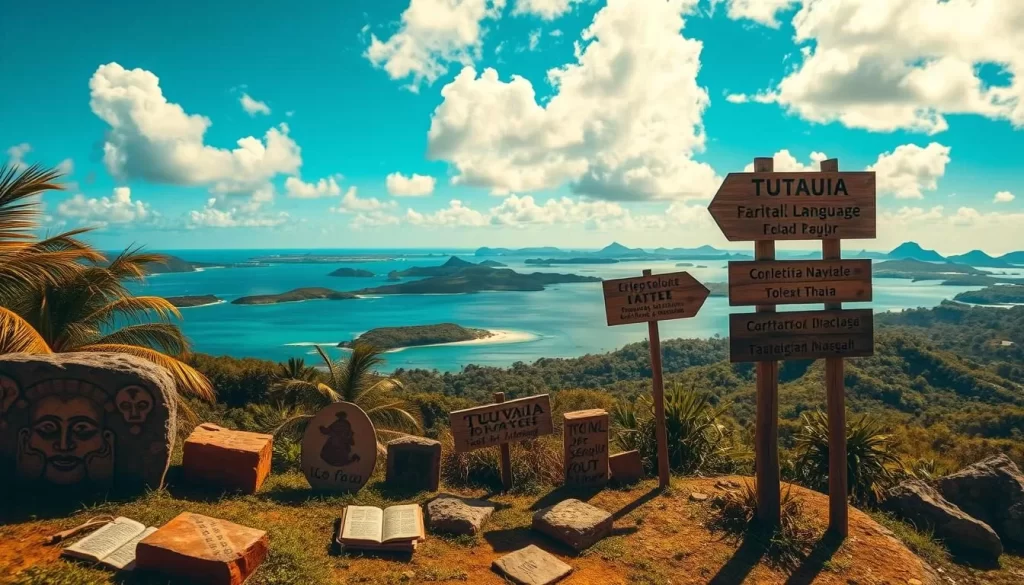
Polynesian contacts played a key role in shaping the language. Patterns of movement across the islands created a vibrant linguistic community. Each interaction added new layers to the evolving dialect.
Migration and Early Polynesian Contacts
Early settlers navigated the Pacific using stars and currents. Their canoe journeys connected distant islands, fostering cultural exchanges. These interactions influenced the language, blending dialects into a unique form.
The population grew as more people settled on the islands. This growth strengthened the linguistic community, ensuring the language thrived. Over time, it became a symbol of identity and unity.
Colonial Influences and the Road to Independence
Colonial rule brought significant changes. During the Gilbert and Ellice Islands period, the language absorbed new influences. Literacy programs introduced during this time transformed how people communicated.
As the islands moved toward independence, the language became a tool for unity. The community embraced it as a way to preserve their heritage. Today, it stands as a testament to their resilience and history.
Tuvalu: Official and widely spoken languages
The official tongue of this Pacific land is more than just a way to communicate. It’s a bridge to the past, connecting the group to their ancestors. Over 10,000 people speak this language, with around 2,000 more using it abroad. This shows its enduring significance in their lives.
Language here is deeply tied to culture. Traditional music, for example, often features lyrics in the native dialect. These songs tell stories of the land and its people, preserving history in a way that’s both beautiful and meaningful.
Modern settings also highlight the language’s vitality. Radio broadcasts in the native tongue keep the community informed and connected. These programs are a lifeline, especially for those living on remote islands.
The unique heritage of this group ensures the language remains vibrant. Despite challenges, it continues to thrive, a testament to the resilience of its people. As you listen to their words, you’ll feel the heartbeat of their culture.
Phonology and Morphology in the Tuvaluan Language
The sound structure of Tuvaluan reveals its Polynesian roots. Its phonological features are distinct, with a system of vowels and consonants that set it apart from other languages. These elements are not just sounds—they carry cultural significance and historical depth.
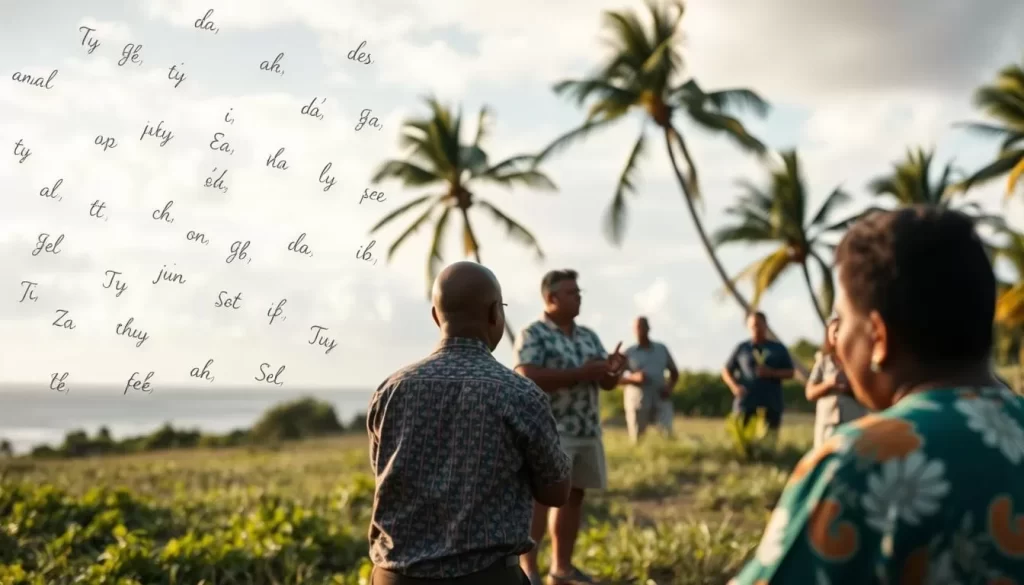
Vowel and Consonant Characteristics
Tuvaluan has five vowel sounds: /a/, /e/, /i/, /o/, and /u/. These vowels can be short or long, adding nuance to pronunciation. Consonants include /p/, /t/, /k/, /m/, /n/, and others, creating a balanced phonetic system.
Historical influences, such as connections with New Zealand, have shaped these sounds. The language’s phonology reflects its Polynesian heritage, with similarities to other dialects in the region.
Word Order, Reduplication, and Tense Markers
Word order in Tuvaluan typically follows a subject-verb-object pattern. Reduplication, or repeating parts of a word, is common. It can indicate intensity, plurality, or ongoing action.
Tense markers are used to show when an action occurs. For example, the prefix “ka-” indicates future tense, while “na-” marks the present. These features make the language both expressive and precise.
| Feature | Example | Function |
|---|---|---|
| Reduplication | fano (go) → fanofano (keep going) | Indicates repetition or intensity |
| Tense Marker | ka-fano (will go) | Shows future action |
| Word Order | E fano a ia (He goes) | Subject-verb-object structure |
These linguistic features are more than grammar rules—they are a reflection of identity. From the Gilbert Ellice Islands to modern times, Tuvaluan continues to evolve while preserving its essence.
Influences from Samoan, Gilbertese, and English
The blending of Samoan, Gilbertese, and English has shaped the linguistic landscape of this Pacific nation. These influences have created a unique fusion, reflecting the island’s history and cultural exchanges. Over time, this mix has become a cornerstone of the community’s identity.
The Impact of Missionary Language Promotion
Missionaries played a significant role in reshaping language practices. They introduced literacy programs, which transformed how people communicated. This effort helped preserve the native tongue while integrating new elements.
Their work also brought written forms to the islands. This shift from oral traditions to written records marked a turning point in the nation’s history. It allowed stories and knowledge to be passed down more effectively.
Modern Integration of English in Government and Education
Today, English is integral to daily life. It’s widely used in government operations and educational systems. This integration ensures the nation remains connected to the global community.
Educational reforms have further strengthened this role. Schools now teach both the native language and English, preparing students for diverse opportunities. This dual approach helps preserve cultural heritage while embracing modernity.
- Samoan and Gilbertese influences merged with the indigenous language.
- Missionaries reshaped language practices through literacy programs.
- English is now essential in government and education.
These changes highlight the resilience of the island’s linguistic identity. From early influences to modern reforms, the language continues to evolve, reflecting the nation’s rich history and vibrant future.
Dialects and Variations Across the Atolls
Across the atolls, dialects reflect the unique cultural practices of each region. These variations are shaped by geography, history, and daily life. From the northern to southern areas, you’ll notice distinct phonetic and vocabulary features that highlight the linguistic richness of this small nation.
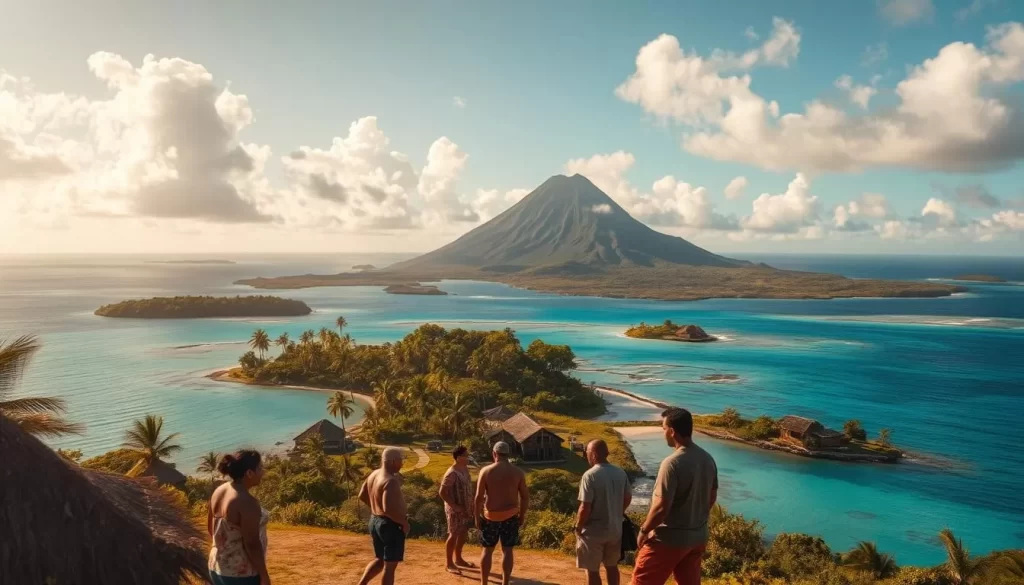
In the north, the dialect often includes softer vowel sounds and specific terms related to fishing practices. The southern regions, on the other hand, use sharper consonants and words tied to reef navigation. These differences are more than just linguistic—they’re a reflection of the communities’ way of life.
Northern vs. Southern Dialect Features
The northern dialect is influenced by its proximity to the Gilbert Ellice Islands. Words like “faka” (to make) are common, while the southern dialect uses “fakamau” for the same meaning. These variations are passed down through generations, often reinforced by local schools and community gatherings.
Daily activities like fishing also play a role in shaping dialects. In the north, terms for specific fish species differ from those in the south. This linguistic diversity is a testament to the nation’s cultural richness and adaptability.
Community interactions further strengthen these dialects. Whether at a school event or a village meeting, language remains a vital part of identity. As you explore these regions, you’ll discover how dialects connect people to their heritage and environment.
Oral Traditions, Music, and Cultural Expressions
The heart of this community’s identity lies in its songs and stories. These oral traditions have been passed down through generations, preserving the essence of their culture. From the rhythmic beats of traditional music to the tales of ancestors, every expression tells a story of resilience and pride.
Preservation of Traditional Songs and Folklore
Traditional songs often feature themes tied to daily life, such as the importance of the coconut and local food. These songs are more than melodies—they are a way to honor the land and its resources. Folklore, too, plays a vital role, with stories that teach lessons and celebrate the community’s history.
Efforts to preserve these traditions involve collective work. Elders share their knowledge with younger generations, ensuring that the songs and stories remain alive. This time-honored practice strengthens bonds and fosters a sense of belonging.
Transition from Oral to Written Forms
Over time, there has been a shift from oral to written forms of expression. This transition allows for greater preservation and accessibility. Written records of songs and folklore ensure that they are not lost, even as the community evolves.
This change reflects the adaptability of the culture. While oral traditions remain central, written forms provide a bridge to the future. They allow the community to share their heritage with a wider audience, ensuring its survival for generations to come.
For more insights into the significance of oral traditions, explore this detailed study.
Impact of Climate Change on Language Preservation
Climate change is reshaping the cultural and linguistic landscapes of island communities worldwide. Rising sea levels pose a significant threat, not only to the physical state of these islands but also to the preservation of their unique languages and traditions.
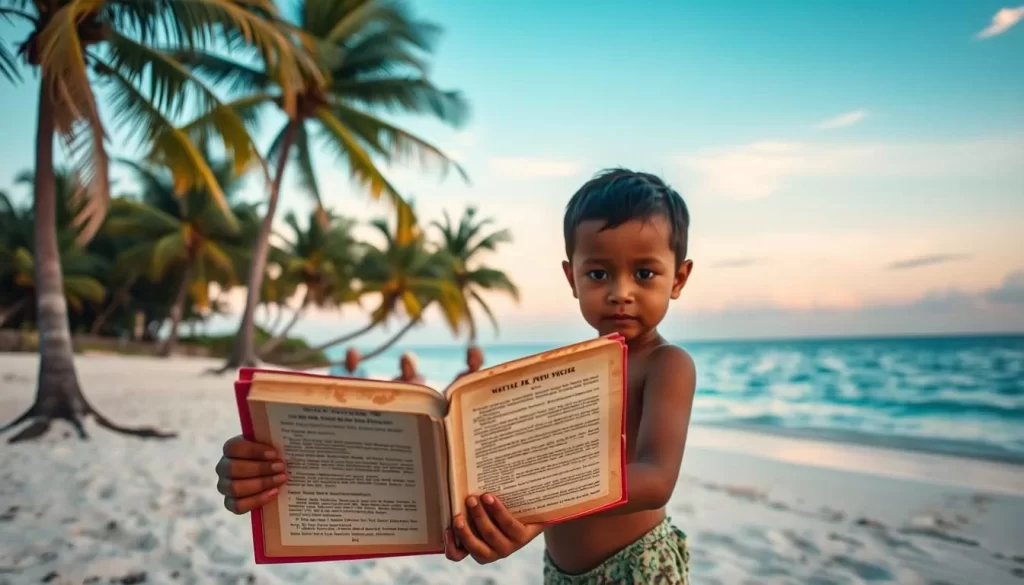
For many island communities, the activity of daily life is deeply tied to the environment. Fishing, for example, is not just a livelihood but a cultural practice passed down through generations. As sea levels rise, the ability to engage in these traditional practices diminishes, threatening the very fabric of their identity.
Education plays a crucial role in safeguarding these languages. Schools are increasingly incorporating traditional knowledge into their curricula, ensuring that younger generations remain connected to their heritage. This education effort is vital in the face of environmental challenges.
Effects of Rising Sea Levels on Island Communities
Rising sea levels are causing unprecedented changes. By 2050, much of the land in these communities, including critical infrastructure, is projected to be below the level of the current high tide. This not only disrupts daily life but also forces communities to consider relocation, which can lead to the fragmentation of linguistic groups.
Extreme weather events, such as hurricanes, further exacerbate these challenges. These events can destroy homes, schools, and cultural sites, making it even harder to preserve traditional languages and practices.
Community actions are essential in addressing these threats. Local initiatives focus on both environmental adaptation and cultural preservation. For example, some communities are creating digital archives of their languages, ensuring that they remain accessible even if physical records are lost.
| Community Action | Purpose | Impact |
|---|---|---|
| Digital Archives | Preserve language records | Ensures accessibility |
| Educational Programs | Teach traditional knowledge | Strengthens cultural ties |
| Environmental Adaptation | Protect against rising seas | Supports community resilience |
These efforts highlight the resilience of island communities. Despite the challenges, they continue to find innovative ways to protect their languages and cultures. For more information on how climate change is affecting these regions, visit this detailed resource.
Education, Media, and Language Revitalization Initiatives
Education and media are powerful tools in preserving and revitalizing cultural heritage. Over the past century, these channels have played a crucial role in shaping identity and ensuring the survival of traditional languages. Today, innovative programs and modern materials are being used to engage communities and pass down knowledge to future generations.
Role of Schools and Educational Programs
Schools are at the forefront of language revitalization efforts. The Tuvalu National Curriculum Policy Framework (TNCPF) is a groundbreaking initiative that covers all levels of education, from pre-school to Year 13. This comprehensive approach ensures that students receive a quality education while staying connected to their cultural roots.
Programs like the Pacific Languages Strategy support bilingual education, with at least 51% of instruction time dedicated to indigenous languages. This method helps students build a strong foundation in their native tongue while also learning global languages. Such initiatives are essential in preserving the unique culture of island communities.
Radio, Digital Media, and Community Outreach
Media plays a vital role in keeping traditions alive. Radio broadcasts in the native language serve as a lifeline for remote communities, providing news, stories, and educational content. Digital platforms are also being used to create accessible materials, from podcasts to online courses, ensuring that language learning reaches a wider audience.
Community outreach programs further strengthen these efforts. Local initiatives focus on engaging both young and old, fostering a sense of pride in their heritage. These programs often include workshops, storytelling sessions, and cultural events that celebrate the rich history of the islands.
For more insights into how bilingual education in the Pacific Islands is shaping the future, explore this detailed resource.
Government Policies and Community Efforts in Culture Sustenance
Government policies and community efforts play a pivotal role in preserving cultural heritage. Legislative measures are designed to protect and promote traditions, ensuring they remain vibrant for future generations. These initiatives are complemented by grassroots actions, creating a unified approach to cultural sustenance.
Language Policy and Legislative Measures
Legislation in this Pacific nation emphasizes the importance of language preservation. Policies are in place to integrate traditional dialects into education and public life. For example, the Tuvalu National Curriculum Policy Framework ensures that students learn their native language alongside global languages.
Community efforts, often led by missionary groups, have been instrumental in these initiatives. They promote literacy and cultural awareness, bridging the gap between policy and practice. These actions highlight the collaborative spirit of the nation.
Education and Student Participation
Schools are at the forefront of cultural preservation. Programs encourage student participation in traditional activities, fostering a deep connection to their heritage. Bilingual education models, supported by the Pacific Languages Strategy, ensure that young people remain rooted in their culture.
Media also plays a crucial role. Radio broadcasts and digital platforms provide accessible resources for learning and engagement. These efforts ensure that cultural practices are not only preserved but also celebrated.
“Preserving our language and traditions is not just about the past—it’s about securing our future.”
For more insights into how Tuvalu integrates sustainable development goals, explore this detailed resource.
- Legislative measures support language preservation and cultural activities.
- Community efforts, including missionary-led initiatives, complement official policies.
- Education programs engage students in reinforcing cultural practices.
These combined efforts ensure that traditions remain alive, reflecting the resilience and unity of the community. Through policy and action, the nation continues to safeguard its rich heritage.
Cross-Cultural Exchanges and Global Linguistic Influence
Global connections have shaped the linguistic and cultural identity of this Pacific community. Over time, interactions with neighboring nations and international migration have enriched their traditions and language. These exchanges highlight the dynamic nature of culture in an interconnected world.
Connections with New Zealand and Other Pacific Nations
New Zealand has played a significant role in influencing this community’s culture. With several hundred Tuvaluans living there, the exchange of ideas and practices has been profound. This relationship has led to the adaptation of certain traditions while preserving core values.
Other Pacific nations, such as Fiji and Kiribati, also contribute to this cultural exchange. These connections foster a sense of unity and shared identity among the islands. Through diplomatic action, these relationships continue to strengthen, ensuring mutual support and collaboration.
International Migration and Cultural Adaptation
Migration has been a key factor in shaping the community’s linguistic landscape. Many Tuvaluans have moved abroad, particularly to New Zealand, seeking better opportunities. This movement has led to the blending of cultures, creating a unique fusion of traditions.
Despite these changes, the community remains committed to preserving its heritage. Through actions like cultural festivals and language programs, they ensure their name and identity endure. This balance of adaptation and preservation is a testament to their resilience.
| Influence | Impact |
|---|---|
| New Zealand | Cultural exchange and migration |
| Fiji and Kiribati | Shared identity and unity |
| International Migration | Blending of traditions |
These global interactions demonstrate the importance of cross-cultural exchanges. They not only enrich the community’s culture but also ensure its survival in a changing world.
Conclusion
Throughout this exploration, you’ve seen how language and history intertwine to shape the identity of this Pacific nation. From early migrations to modern efforts, the preservation of cultural heritage remains a priority. The community’s resilience is evident in their commitment to maintaining traditions while embracing change.
Independence in 1978 marked a turning point, allowing the nation to reclaim its cultural roots. Today, the church and government play vital roles in sustaining these efforts. Their combined influence ensures that the language continues to thrive, even in the face of global challenges.
This journey highlights the importance of unity and adaptability. By valuing their independence and cultural identity, the community sets an inspiring example. Their story reminds us that language is more than words—it’s a bridge to the past and a foundation for the future. For more on their history, visit this detailed resource.
The above is subject to change.
Check back often to TRAVEL.COM for the latest travel tips and deals.
